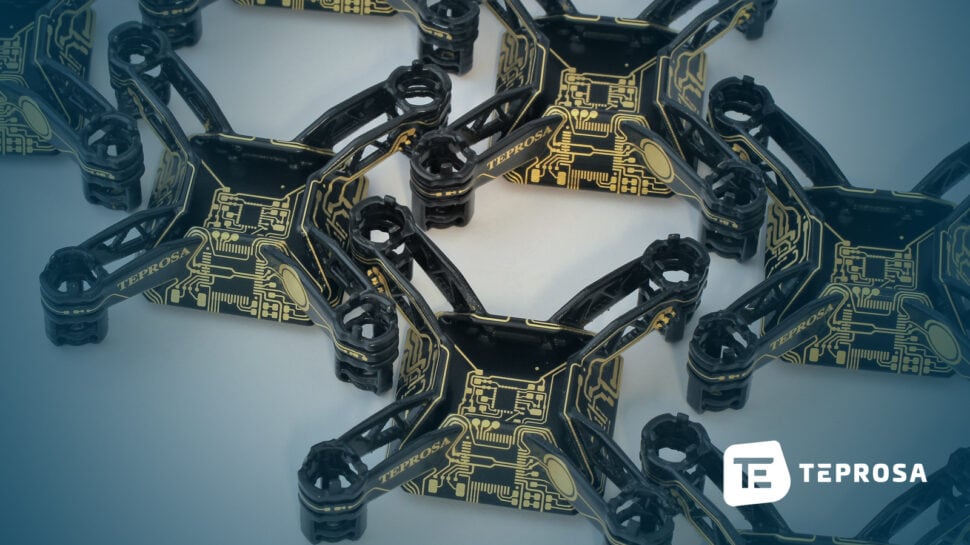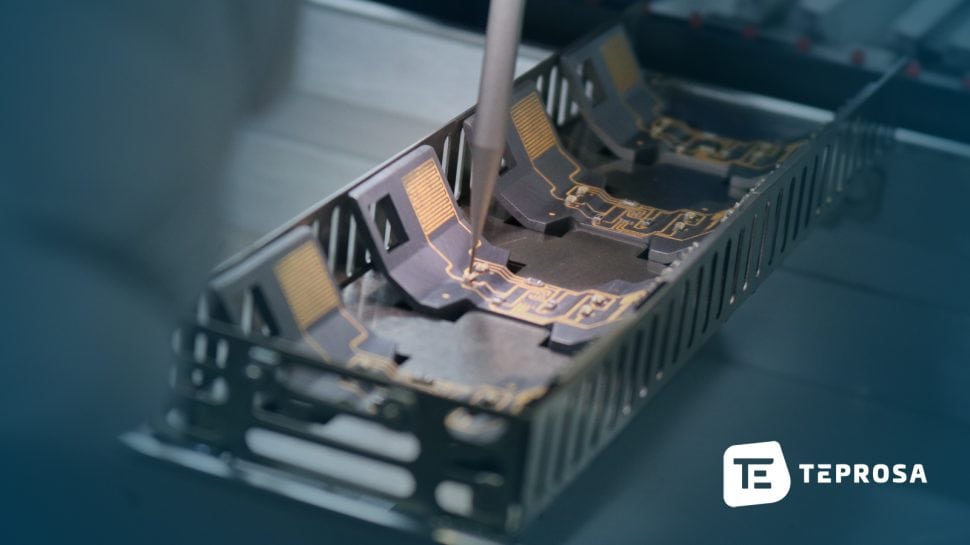Manufacturing of 3D-MID
Various manufacturing options exist for the production of 3D-MID. In addition to 2C injection molding, the laser resist method and hot stamping, the LPKF-LDS method (laser direct structuring) developed by the German mechanical engineering company LPKF Laser&Electronics AG is one of the most common methods for manufacturing mechatronic integrated devices.
We manufacture exclusively using the method developed by LPKF and the laser resist method.
The production of Mechatronic Integrated Devices/MID using the LPLF method is carried out in a process chain with the following four basic process steps:
1. Base body generation (injection molding, 3D printing)
In the first process step, the basic body is created that will later be used as a circuit carrier. Plastics (mostly thermoplastics) provided with special additives are used for this purpose. These plastics are processed by injection molding and increasingly by 3D printing.
2. Laser direct structuring of mechatronic integrated devices
Laser direct structuring “exposes” the special additives contained in the plastic. The process used for this was developed by LPKF Laser & Electronics AG. During ablation of the top injection molding skin, the nuclei underneath are activated by the laser beam and thus modified for subsequent metal adhesion.
3. Metallization of Mechatronic Integrated Devices
The plastic bodies modified by laser direct structuring can be further processed chemically or galvanically in special metallization processes. The additives exposed during structuring serve as seedlings for copper particles in the chemical metallization process step.
In this way, an initial conductive layer is created, which can be reinforced in further metallization processes or supplemented with other metals (e.g. nickel, gold). In chemical metallization, metallization is performed without current, while in galvanic metallization the components are electrically contacted.
In this way, even higher layer thicknesses can be achieved during metallization. The most commonly used layer structure consists of a layer of copper, followed by a layer of nickel and a final layer of gold (flash gold).
4. Assembly of Mechatronic Integrated Devices
In the final process step of manufacturing an MID, the Mechatronic Integrated Devices can be assembled with electronic components. Mechatronic Integrated Devices/MIDs can basically be assembled in the same way as conventional printed circuit boards.
However, the assembly of three-dimensional circuit carriers presents a particular challenge if many components are to be placed on different levels of the MID assemblies, resulting in a complex component design.
In series production, however, inefficiencies caused by an unnecessarily complex component design or an incompletely thought-out placement of the individual components quickly become a major cost driver.
Bestückung eines dreidimensionalen Schaltungsträgers (3D-MID) bei TEPROSA
Advantages of Mechatronic Integrated Devices/MID
The use of MID technology enables the integration of mechanical and electronic functions and can thus contribute to the miniaturization of an assembly. Design freedom in development, reduction of assembly costs and other cost benefits are further advantages of the technology.
- High design freedom for electronic component development
- Integration of additional functions for plastic parts (antennas, RFID elements, switches, shields, stitch connectors…)
- High degree of miniaturization possible
- Reduction of assembly costs, for example through monolithic integration
- Prototype production cost-effective and fast in 3D printing process
Prototyping and feasibility studies for mechatronic integrated devices
When applying MID technology, there are many details to consider from the very beginning. Having the challenges of subsequent manufacturing in mind from the initial design of the 3D body can have a significant impact on the economics and performance of the eventual MID.
Materials for Mechatronic Integrated Devices
There are now a large number of laser-activatable thermoplastics that contain the necessary metallic additive and are therefore suitable for the production of MIDs using LPKF’s laser direct structuring process. Here you will find a selection of the basically available polymers:
- PC (polycarbonate)
- PC + PET (polycarbonate (PC) with the properties of polyethylene terephthalate (PET))
- PC/ABS (polycarbonate (PC) with the properties of acrylonitrile butadiene styrene (ABS))
- PA/PPA (polyamide (PA) with the properties of polyphate halamide (PPA))
- PA6 (polyamide 6)
- PPA (polyphathalamide)
- PA4 (polyamide 4)
- PA66 (polyamide 66)
- LCP (Liquid Crystal Polymer)
- PEEK (Polyetheretherketone)
- PPS (polyphenylene sulfide)
- PET (polyethylene terephthalate)
- PEI (polyetherimide)
- PBT (polybutylene terephthalate)
- PET + PBT (polyethylene terephthalate)
- COP (Cyclic Olefin Polymer)
- PPE (Polyphenylene Ether)
We are happy to advise you on the selection of plastic pellets, the appropriate process and take care of the procurement for you. A selection of common plastic granules we always have in stock, so we can start immediately with your project.
Our quality management
As a service provider for the manufacturing of Mechatronic Integrated Devices, we have set ourselves the goal of manufacturing products with the highest quality standards. To achieve this goal, we work within the framework of our quality management system according to clearly defined processes, which we constantly review and develop. For us, quality does not only refer to the products, but to all business processes. You can find more information about our quality management system and processes here.
The Research Association 3 D-MID
.
TEPROSA is a member of the Research Association 3 D-MID and also participates in the direction of research on Mechatronic Integrated Devices as part of the Research Advisory Board.















